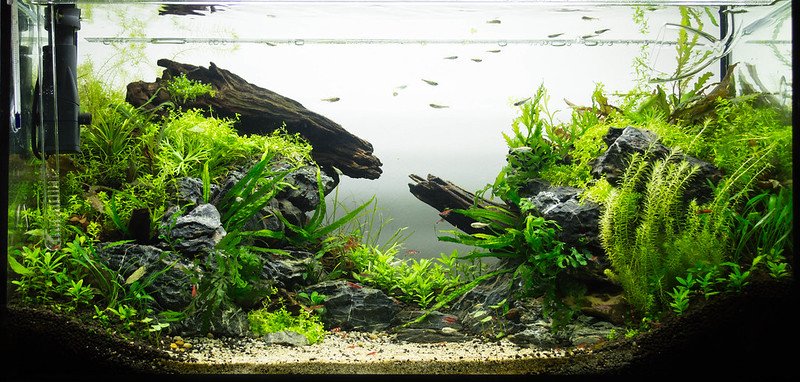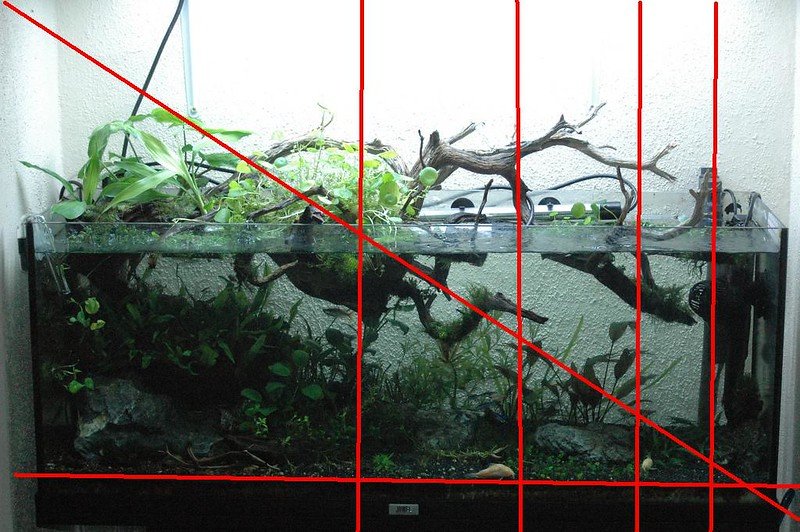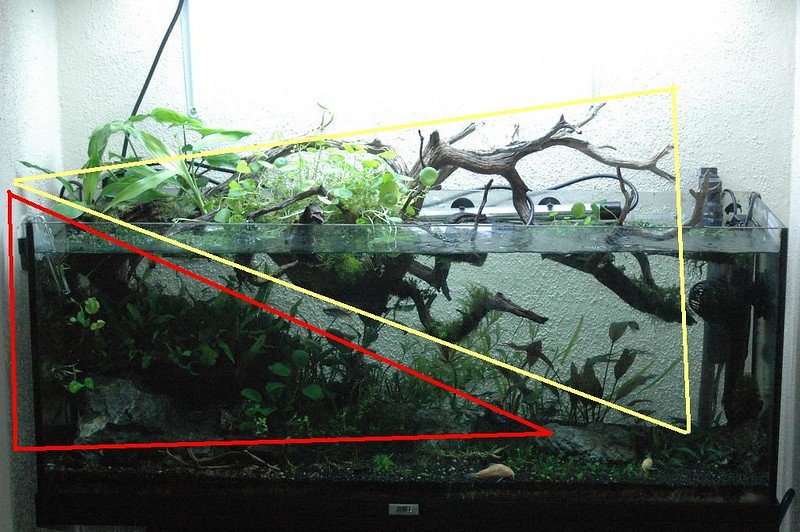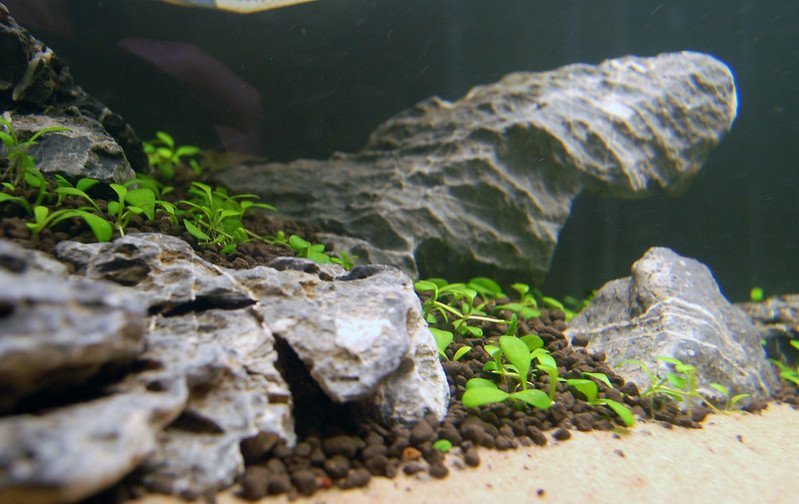Aquascaping is the arrangement of rocks, driftwood and live plants in an aquarium to create a visually appealing scene.
Basically, it’s really meticulous decorating, planned out to the tiniest detail.
The goal of aquascaping isn’t always to make the aquarium look like a natural waterway. Often, inspiration is drawn from terrestrial environments, like mountains, forests or jungles.
Many aquarists approach setting up a tank from the perspective of the livestock we intend to keep.
Things like hardscape, substrate and plants are placed in the aquarium because we’re trying to fulfill the needs of certain fish.
Aquascaping is a bit different. The plants and hardscape, and how they come together, are the main focus of the tank. It’s more about creating a piece of art.
Livestock like fish and invertebrates are almost an afterthought.
Basics of Aquascaping

Avoiding Symmetry
Aquascapers do their best to avoid symmetry. Perfect symmetry really doesn’t occur in natural scenes.
Most aquascapes are trying to recreate scenes from nature, so that you forget that you’re looking at an aquarium and feel as if you’ve wandered upon a picturesque landscape.
Avoiding symmetry helps to keep an aquascape from looking too harsh or manmade.
To keep things looking more asymmetrical, rocks and other focal points are grouped in uneven numbers, never in pairs.

Elements are also placed off center instead of dead center.
Focal Points
Basically, focal points are elements in your aquascape that draw the eye. Maybe it’s a spectacular rock or a vibrant red plant.

No matter what the focal point is, it’s important to place it carefully in the tank.
A lot of the principles of aquascaping are all about drawing the eye to your focal point and displaying it with the best possible effect.
But, it has to be placed in the right spot or it ruins the overall scene.
Rule of Thirds
The rule of thirds actually comes from photography and cinematography. It’s used when deciding what angle to shoot film from to make a scene look more dynamic and interesting.
It’s a more simplified version of the golden ratio, which I will discuss in the next section.
Essentially, an imaginary grid is placed over the front glass of the aquarium with two horizontal lines and two vertical lines. This divides the tank into nine equal segments.
Focal points are placed either along one of the lines or where the lines intersect. This prevents exact symmetry and makes the scape look more natural. It also creates tension that draws the viewer’s eye back to the focal points.
The Golden Ratio
OK let’s dive into a little math.

Don’t groan at me! This concept really is pretty cool.
This is going to get a little bit abstract, but stick with me.
The golden ratio has, since ancient times, been considered the key to creating beauty in art and architecture.
It all boils down to having a rectangle whose proportions have the ratio of 1:1.618.
So, if the short side of the rectangle is 1 foot wide, the long side would need to be 1.1618 feet long. If the the short side was 2 feet, the long side would need to be 3.326, and so on.
Once you have a golden rectangle, you divide it horizontally by drawing a line that creates a square and a rectangle.
For example, if your original rectangle is 3.326 X 2, you would have a square that is 2 X 2, and rectangle that is 2 X 1.236. The 2 X 1.236 rectangle will have the same proportions as the original, since 2 divided by 1.618 is about 1.236.
Still with me? If not, too bad, I’ll keep going anyway.
You can then draw another golden rectangle inside the 2 X 1.326 one. This second rectangle will be turned 90° from the original. You can divide the second golden rectangle just like you did the first, then draw a third golden rectangle inside that.
Technically, you could keep doing this on into infinity, but I don’t know about you, my eyes would start to get pretty squiggly after a while.
Don’t worry, when it comes to aquascaping, you only use five golden rectangles in total.
If you then draw a curving line that runs through where each of the rectangles and squares meet, in each of the golden rectangles, it will form a perfect spiral.
This framework of intersecting lines, and the spiral it creates, has been used as a guide to create great works of art and architecture for centuries.
This same principle can also be found in nature. Golden ratio spirals can be found in everything from nautilus shells to galaxies.
So, how does this apply to fish tanks again?
Well, if you divide up the front glass of your aquarium using the golden ratio, you can use it as a guide so you know where to best place focal points in your aquascape.
By arranging elements according to the golden ratio, the viewer’s eye will naturally be drawn around to the different focal points again and again.
It creates a balance that is both pleasing and relaxing, two things an aquarium should always be anyway!
Related: Best Tools For Aquascaping
Foreground, Midground and Background
Figuring out where you’re going to place plants and hardscape is really important.
If you put your tallest rocks and plants right in the front of the tank, you won’t be able to see anything else.
So tall things should go in the back, short things in the front and the middle is for everything in between.
But it’s not just about your view being blocked. By staggering elements in the tank by size, you help to create an illusion of depth that actually makes your tank look bigger.
So make sure you follow these basic principles:
- Foreground – use your shortest plants and rocks. This is where you would put things like small stones or low-growing carpet plants.
- Midground – this is where your middle height plants and hardscape should go. It’s OK to place taller focal points on the border of the midground and background if needed.
- Background – this is where your tallest plants and hardscape should be placed. This is a good spot for tall stem plants or really tall pieces of driftwood.
Choosing Plants
Choosing plants can be tricky and takes a lot of research.
Factors to consider when choosing plants:
- Size of your tank – you have to know just how big a plant is going to get before you place it in your tank. Keep in mind, when you purchase plants, many are very young and may grow much larger. Something like an Amazon sword could easily outgrow a 55 gallon as it matures. So don’t put it in a 10 gallon!
- Style of aquascape – if you’re going for a certain style of aquascape, like Iwagumi or jungle, selecting the right species of plant is essential to pulling off the right look. Broad leaf plants are favored for jungle, small carpet plants for Iwagumi, a variety of carpet and stem plants are good for nature aquariums and a huge variety of colors and textures are used in Dutch style.
- Placement in the tank – knowing where the plant will go is essential. Something tall, like Jungle val, should be in the background and short carpet plants like dwarf baby tears should be in the foreground. Luckily, most plant species are listed as to whether they go in the foreground, midground or background.
- Plant demands – just like different species of fish, aquarium plants have varying requirements. Some, like Java fern or anubias, thrive with poor lighting and benign neglect. On the other end of the spectrum, something like Rotala macrandra needs
intense lighting and CO2 injection. It’s important to pick plants that match the level of care you can provide.
Related: Best Aquarium Plants For Beginners
Hardscape
Hardscape is literally just the hard elements that you place in the tank, like rocks and driftwood.

Hardscape is the backbone of any aquascape. It lays out the shape and form that you build the rest of the elements around.
The Shape of the Scape
Using your hardscape, you can create an overall shape that draws the eye to different focal points within the aquarium:
- Concave – the hardscape and plants are highest on opposite ends of the aquarium, sloping down to the lowest point near just off center. Often, there is a gap in the middle that is left as bare substrate that curves off towards the back of the tank. This adds to the illusion of depth in the aquarium.
- Convex – (aka island shape) the opposite of concave, plants and hardscape are at their highest point in the middle of the aquarium and slope down on both sides.
- Triangle – plants and hardscape are at their highest point at one side of the tank and slope down to the substrate on the other side. This gives a strong contrast between the mounded focal features and the large open area. This contrast naturally brings the eye to the focal point at the apex of the triangle.
- Linear – this is a relatively new design shape that is gaining popularity. It’s creator, James Findley, places hardscape along a straight line but chooses interesting pieces so that it mimics natural forms like a fallen tree or a mountain range.
Different Styles of Aquascaping
Nature Aquarium Style
The nature aquarium style was invented by the famous Japanese landscape photographer and aquascaper, Takashi Amano.
Amano approached aquarium design in a new way. Instead of trying to mimic underwater environments, he set out to make his aquarium designs mimic photographs of natural landscapes.
His style was to arrange elements in the tank so that focal points drew the eye around the tank, much like choosing the best and most interesting angles for photographs.
Nature aquariums are deceptively simple in design, using both hardscape, plants and open swimming areas to mimic mountain ranges, forests and other natural landscapes. By using the golden ratio, the eye is drawn to the main focal point of the tank.
It’s common for the hardscape in a nature aquarium to incorporate both rocks and driftwood pieces.
Iwagumi Style
Iwagumi is roughly translated as “rock formation.”
It is a subset of nature style aquariums, but the primary focal points are large pieces of bare stone, instead of driftwood or plants. The stones are arranged so that they look like a distant mountain range.
There are a few rules that govern Iwagumi style aquariums.
- Rocks should be similar in color and texture, but should be different sizes and shapes.
- An odd number of rocks should always be used. An even number looks to symmetrical and manmade. This goes against the principles of mimicking natural formations.
- The largest stone is always the focal point. It should be the most attractive stone of the bunch.
- Mostly low-lying plants should be used. The stones should be the star of the tank. Tall, bushy or flashy plants would detract from the beauty of the stones.
Dutch Aquarium
Dutch aquascaping focuses primarily on the aquatic plants. Some rocks and driftwood can be used, but they are not really the focal points.
The overall look is that of a lush garden, rather than a natural creek bed or some other natural environment. Despite the thick growth of plants, the overall look is very simple and neat.
Usually, about 70% of the aquarium is dedicated to dense plant growth. Sometimes the substrate is terraced to add further depth.
Generally, thin leaved, stemmed plants are favored. Floating, broad-leaved and overly tall plants are not used.
Plants are usually put together in neat sections of the same species. And there is a big focus on contrasting the colors and textures of the different species so that each section is easy to distinguish from the others.
Jungle Style
The Dutch style looks very neat and orderly. In contrast, the jungle style looks overgrown and a bit more chaotic.
There’s much more emphasis on creating a more natural and tropical-looking environment.
This style of aquascaping is like a nature aquarium but a bit more fluid. The main goal is to make something a bit messy yet very beautiful, as if you had stumbled upon a patch of submerged rainforest.
Broad leaf plants like Amazon swords, Echinodorus uruguayensis or Cryptocoryne undulata are favored since they grow large and bushy.
Floating plants are used to break up direct light. This creates an effect like dappled sunlight similar to what you see on a forest floor.
